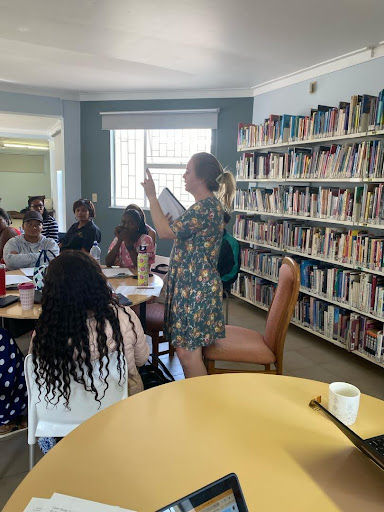Creating a Thriving Learning Environment for Children: At home and at school
- Windhoek International School
- Oct 6, 2023
- 3 min read
Dear WIS Community,
During this morning’s Lower Primary Sports Day Celebration, I coincidentally had two separate discussions with parents about the various ways children manifest anxiety surrounding school. For some, it takes the form of perfectionism, while for others, it emerges as a reluctance to participate in group activities. These parents have pondered how best to support their children and whether their everyday interactions might unknowingly influence these behaviours.
As educators, we are no different. As reflective practitioners, we must consider how we shape our classroom culture. Our daily interactions with students are crucial. The language we employ in the classroom significantly impacts the culture and the sense of safety and security children experience. Ron Ritchhart, a renowned educational researcher and author, introduces "Language Moves" as a powerful tool to cultivate a positive classroom environment. Importantly, these language moves can also be applied by parents to create a conducive atmosphere for learning at home.

Talk Less, Talk Purposefully
In the Classroom: Encourage students to engage in thoughtful discussions and express their ideas rather than relying solely on lectures.
As a Parent: Foster two-way conversations by asking questions that stimulate your child's thinking.
Ask Open-Ended Questions
In the Classroom: Pose questions that encourage critical thinking, deep exploration, and diverse perspectives.
As a Parent: Promote reflection and self-expression by asking questions that invite your child to elaborate on their experiences and feelings.
Offer Wait Time
In the Classroom: Allow students time to formulate responses, enabling them to think before answering.
As a Parent: Cultivate patience when seeking answers or explanations from your child, giving them space to collect their thoughts.
Routinely Use Accountable Talk
In the Classroom: Promote accountable talk, where students substantiate their ideas with evidence and engage in respectful discourse.
As a Parent: Encourage your child to express opinions with reasoning and evidence during discussions at home.
Value All Responses
In the Classroom: Demonstrate appreciation for diverse answers, fostering inclusivity and respect.
As a Parent: Validate your child's thoughts and feelings, even when they differ from your own, to create an open and accepting environment.
Highlight Thinking Growth
In the Classroom: Emphasise the learning process and the development of critical thinking skills over correct answers.
As a Parent: Acknowledge your child's efforts and improvements, reinforcing the idea that learning is a continuous journey.
Facilitate Group Discussion
In the Classroom: Encourage collaborative learning by organising group discussions, where students can share and build on each other's ideas.
As a Parent: Create opportunities for family discussions, allowing everyone to contribute and helping your child develop their communication skills.

As parents, we continually seek ways to enhance our parenting skills, aiming not just for survival but for our children to thrive. This brings to mind a valuable resource, "The Whole-Brain Child." This book, authored by Dr. Daniel J. Siegel and Dr. Tina Payne Bryson, explores brain development in children and offers practical strategies for nurturing emotional and cognitive growth. It blends scientific research with real-world parenting techniques, helping parents raise well-adjusted children.
This book is loved by teachers and parents for its empowering tips and ideas.
One specific strategy from the book is "Name It to Tame It," which can help address issues like perfectionism in children:
Acknowledge the Feeling: Recognize and validate your child's emotions, such as frustration over making a mistake.
Label the Emotion: Help your child identify and label the specific emotion they are experiencing, like disappointment.
Normalise the Emotion: Let your child know it's okay to feel that way and that making mistakes is part of learning and growth.
Problem-Solve Together: Encourage your child to brainstorm solutions or strategies for handling similar situations in the future, empowering them to learn from their mistakes.
By employing the "Name It to Tame It" strategy, you can enhance your child's emotional intelligence, resilience, and ability to cope with challenges constructively. I highly recommend "The Whole-Brain Child" to both teachers and parents as a valuable resource for supporting children's development.
Cultivating a Growth Mindset: A Valuable Resource by Carol Dweck

Using these statements at home will help develop a growth mindset in your child
In our ongoing pursuit of fostering positive learning environments, another invaluable resource to consider is the work of Carol Dweck, particularly her groundbreaking concept of the "Growth Mindset." In her book, "Mindset: The New Psychology of Success," Dweck explores the idea that individuals can develop their abilities and intelligence through dedication and hard work. By adopting a growth mindset, both parents and teachers can empower children to embrace challenges, persevere through setbacks, and view failures as opportunities for growth. Dweck's research and insights provide practical strategies for nurturing resilience, determination, and a love for learning in young minds. We use this resource often in the classroom and I encourage everyone to explore this resource as we continue to work together to create environments where every child can thrive.
Have a lovely October break everyone!
Warmly,
Marcelle van Leenen
Primary School Principal








Comments